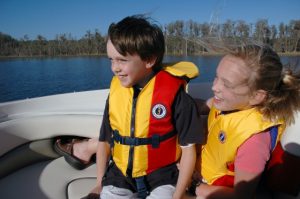2022-May-03
Stats Don't Lie - Lifejacket Wear Studies Show Most Fatalities are Preventable
Study #1 – The Lifesaving Society
The Lifesaving Society – Drowning Prevention Research Centre, the lead agency for drowning research in Canada, shared their data in a 2021 report that described the epidemiology of fatal boating related incidents across Canada for the years 2008-2017.

The Stats
There were almost 500 unintentional water-related deaths each year across Canada for the study years. 21% of these deaths were recreational boating related.
- 91% of these are males
- 45% were in the 35-64 age group
- Children 5-14, where PFD use is highest, account for only ½ of 1% of fatalities
Fatalities by type of vessel:
- Powerboats under 5.5 metres 23%
- Canoe 23%
- Powerboats size unknown 15%
- Power Boat over 5.5 metres 9%
- Kayak 8%
- Personal Watercraft 4%
| Type of Boating Incident | Contributing Cause |
| Capsized 41% | Rough Water 34% |
| Fell/thrown overboard 26% | Strong winds 17% |
| Swamped 8% | Standing up 14% |
| Collision 6% | Object 12% |
| Unknown 17% | Dangerous maneuver 5% |
We can see from this information (the type of vessel, the type of boating incident and the contributing cause) that if people had been wearing lifejackets they would have likely survived.
The majority of recreational boating related deaths in Canada continue to involve individuals who were not wearing a PFD (80%+) and sadly most of these fatalities were avoidable.
Study #2 – Transport Canada
Methodology:
In summer 2021, observations were conducted at 10 marinas across the country to measure wear rates of PFDs/lifejackets among recreational boaters. The observations were carried out by the Office of Boating Safety. Observations took place over four dates: August 7 & 18 and September 4th and 18th. Observers were present at each site for 4 hours each day. They recorded boaters’ age, sex, vessel type and activities and whether they wore a PFD or lifejacket. Other factors such as weather conditions, wind speed and water temperature were also recorded to measure the impact these had on boater behaviour.
The Stats:
Observers documented 4,117 boaters across 1,660 vessels in 2021. Of the total number of observed boaters, 34% were wearing a PFD or lifejacket.
- Wear rates were highest among children at 67% while only 29% for adults – in fact, children aged 6-12 had the highest wear rate at 75%
- Women’s wear rates were 38% versus 31% for men

- The lowest wear rate was for adults 65 and older
The type of vessel impacted wear rates:
- Personal Watercraft had a 94% wear rate
- Kayaks had the second highest
- Motorized boats had the lowest wear rate at 25%
- Rowboats were the second lowest
Wear rates also decreased as the size of the boat increased. Boats under 16 feet had a 59% wear rate and only 20% for boats over 46 feet.
And this finding is a gamechanger. When the vessel operator was wearing a PFD the wear rates among passengers was 85% versus only 16% when not. The role modelling effect is powerful.
Next Steps
Observation results will be used to develop policy options up to the mandatory wearing of PFDs/lifejackets. These options will be shared with safety organizations and partners prior to being presented to Canadians through Let’s Talk Transportation.
Phase 2 – Summer 2022
This project is going to test the effectiveness of different messaging approaches that are in the process of being finalized.
Separate posters will be placed at most of the same sites where the observations were made in 2021, over the same dates, with the observers again observing the wear rates of recreational boaters. Some sites will display the posters with a clearly identified TC observer nearby. Four marinas from Phase 1 will serve as control areas with no poster and no clearly identified observer.
Results will be compared with the 2021 observations. Messages that show the greatest impact may be used to revamp education and outreach strategies.
Study #3 – Canadian Safe Boating Council (CSBC)
“Research that Floats” was designed to create a Lifejacket Wear Rate Report of Ontario Boaters on inland lakes. CSBC wants to determine if a lifejacket wear public education campaign can change lifejacket wear behaviour and to share this broadly among boating safety stakeholders.
 Key Elements
Key Elements
- Conduct a baseline lifejacket wear rate study (completed last year)
- Develop and execute a lifejacket wear communication campaign (in progress)
- Conduct a second lifejacket wear rate study (this summer)
- Conduct an intercept study to determine if wear rate was impacted and to better understand boater lifejacket wear attitudes
- Share the results broadly among boating safety stakeholders
Methodology
There are 4 observation regions in Ontario: Nipissing Lakes; Almaguin, Muskoka & Haliburton lakes; Lake Simcoe and Kawartha Lakes including Lake Scugog & Rice Lake.
The observations were made from the air.
The Stats
- Overall PFD/Lifejacket wear 25%
By Vessel Type:
- PWC 98%
- Kayaks and canoeists 68% (kayakers much higher than canoers)
- Sailors 47%
- Powerboaters (ex PWC) 18%
- Adults in powerboats (ex PWC) 11%
By Age Only:
- Children 87%
- Teens 47%
- Seniors 9%
Next steps
CSBC will launch the education messaging as soon as completed (in time for summer). Posters, signs, online – QR codes, videos, etc. Follow up with an aerial observation study and on water intercepts interviews with boaters in the four aerial observation areas. The intercept interviews will be conducted by enforcement agencies, Nipissing U students, Canadian Sail & Power Squadrons, and local boaters.
What does CSBC hope to learn?
- Wear rates in inland lakes
- What type of messaging works
- Does education work and how well?
- Where are effective touch points?
